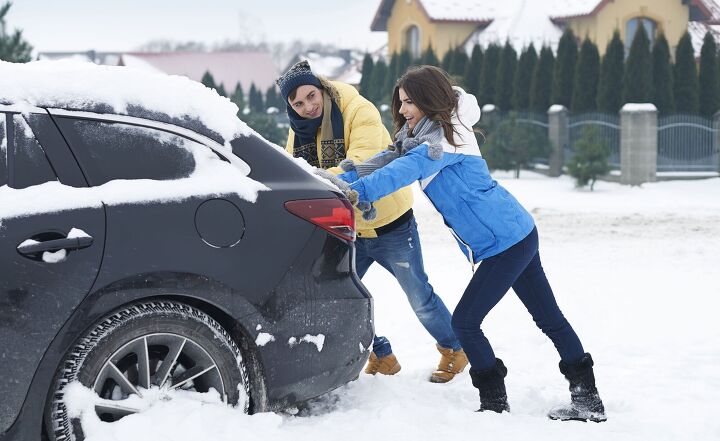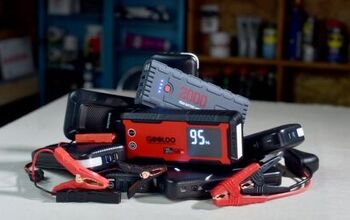8 Steps for When Your Car is Stuck in The Snow

If you drive in the winter, it’s going to happen sooner or later. Your car gets stuck in the snow. Don’t panic, you can usually get your car, truck, or SUV out of the snow without needing a tow truck or other heavy equipment to do the work for you. Here are eight steps for when your car is stuck in the snow.
Table of contents
Step 1 - Don't Get Stuck
The first step is to make sure that your vehicle is doing everything it can to help you get out of that slick spot. If you haven't already put winter tires on your vehicle, then you're starting off in a tough spot, so maybe make those step negative one? The one you do before you're stuck. It's too late for that, though, so now is the time to make sure that if you have 4x4 that you've turned it on. If your vehicle has a "snow" drive mode, select it. And if you can turn off your traction control with a handy switch, do that too. When you're already stuck, turning traction control off can actually make it easier to get unstuck.
Step 2 - Melt Your Way Out
If your tires are spinning, but they aren't buried deeply in snow, you might just be on the tiny patches of ice that can form when your warm tires melt some snow and then it re-freezes overnight. These tiny ice patches can make it surprisingly tough to move the few inches you need to get off of them. The solution? Some ice melt. Ice melts are blends of salts and other chemicals meant to quickly melt that patch of ice and let you get going. spread a thick layer around the front and rear of your drive tires, wait 10-20 minutes, and you should be good to go. Use ice melt on your driveway to make sure you aren't parking on these small bits of snow for next time.
Step 3 - Dig Your Way Out
If the snow is deeper than your sidewalls, it's time to dig. If you had enough traction to drive out of that snow you would have already. A folding shovel fits in your trunk and can stay there all year. Unfold it and use it to dig away at the snow in front of (or behind) your tires, and that's all four tires. Once you've dug the snow away from the tires, and you'll need to do it for a few feet in the direction you want to go, you can now try driving out. If you don't want a large shovel, then keep some waterproof winter gloves in the vehicle. It will take longer than a shovel, but is much, much better than just using your bare hands to dig away snow. Dig out from around your tailpipe, too, to make sure you aren't at risk of filling the vehicle with exhaust from a plugged pipe.
Step 4 - Get Some Traction
If digging isn't enough, then the next step is traction mats. These are plastic (or metal) panels that are designed to be able to support the weight of your vehicle and dig into the ground to give you enough traction to drive away. Traction mats are used for mud as well as snow, but you need to use traction mats designed for snow and ice to really dig into frozen terrain. Don't bother trying to use your floor mats, they'll just get thrown into your wheel wells. You'll have to drag them out and they can break things like your brakes and the electronics in your hubs. Jam the traction mats against your drive tires, in the direction you want to go, and then drive. Once you've gotten unstuck, don't forget to go back and pick them up.
Step 5 - Try it Now
At this point, you're probably ready to drive out. Or at least to try. Start with your left foot gently on the brake and then press gently on the gas with your right foot. Why the brake? Because in most vehicles without AWD, the tire with the least amount of traction will get all of the power and keep spinning. A touch of brake pedal can counter this effect, giving you a better chance of getting out.
Step 6 - Rock it Out
Don't spin the tires. Flooring the gas and spinning like mad is cathartic, but it won't get you out of the snow. All it will do is polish the snow or ice you're stuck in and make it even harder to get your car out of the snow. Gentle applications of the throttle. You can try to "rock" your car forward and backward to try and shake it loose by moving in drive then in reverse, but this isn't good for your transmission. It can overheat and suffer damage.
Step 7 - Pull it Out
At this point, if you're still stuck, you might need some help from a passer-by. If you're lucky, they can give you enough help to push you out, but if you're really stuck, and they have a truck or SUV, you can use a recovery rope and have them pull you out. Using a recovery rope is best saved for emergencies because fastening the strap in the wrong place can leave you with a torn-off bumper or other damage. The strap should be secured to your tow hook (check your manual for the location, even on many cars) and to the tow hook on the other vehicle. Recovery straps are designed with some flex so that the other vehicle can pull you out gently (there is less risk and a better chance of success) than a basic tow strap. Don't use a tow rope or chain, they aren't designed for the stress and could snap and really do some damage.
Step 8 - Be Ready for Anything
Ok, it's time to call for a tow. This is when it's a good idea to keep a 12V phone charger and cable in the car so that you don't need to worry about the cold draining your phone. Stay in the car, or at least don't go out of sight of it. A stranded vehicle is easier to find than a lost person. Keeping an emergency kit in your car with supplies like emergency blankets and candles and even flares can help keep you safe and warm until that tow truck (or other help) arrives. Run your vehicle's engine sparingly, to make sure you don't use all of your fuel and don't drain the battery.
Feature Photo By gpointstudio/Shutterstock
We are committed to finding, researching, and recommending the best products. We earn commissions from purchases you make using the retail links in our product reviews. Learn more about how this works.

Aaron is a freelance writer, videographer and car enthusiast based out of the Detroit area. He has a special affinity for the Porsche 944 series, and once owned a Volvo 240 sedan with a Weber carb in place of the factory EFI system. His work has appeared on AutoGuide, GM Authority, /Drive, and VW Vortex, among other sites.
More by Aaron Brzozowski






































Comments
Join the conversation